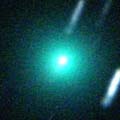
|
New comet discovered by the southern survey ASAS. It was 10.5 mag on Jan. 6 (John Drummond), but it brightened rapidly and reached to 5.3 mag now (Feb. 21, Andrew Pearce). Very strongly condensed, and rather small considering its brightness, with a diameter of only around 4 arcmin. Long tail is also visible. Now it is closest to the sun, and brightest. Finally it became observable in the Northern Hemisphere. It keeps observable in the morning sky while fading gradually. It will be visible visually until May. In the Southern Hemisphere, it is only observable until early March.
Date(TT) R.A. (2000) Decl. Delta r Elong. m1 Best Time(A, h)
Feb. 25 20 15.64 -19 21.2 0.812 0.559 34 5.2 4:14 (284, 14)
Mar. 4 20 30.65 -1 2.4 0.771 0.599 37 5.4 4:22 (266, 9)
|
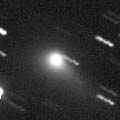
|
It has been visible visually in the southern low sky since last August. Now it is brightest, 10.3 mag on Jan. 30 (Juan Jose Gonzalez). It was very small and sharp before, however, now it looks like a typical diffuse comet. It keeps 10 mag until March. In the Southern Hemisphere, it is not observable until autumn. In the Northern Hemisphere, the altitude is getting lower slowly, and it will be too low to observe in April.
Date(TT) R.A. (2000) Decl. Delta r Elong. m1 Best Time(A, h)
Feb. 25 0 15.67 9 46.1 2.264 1.520 32 10.0 20:11 ( 96, -9)
Mar. 4 0 36.20 12 42.9 2.284 1.524 31 10.0 20:00 ( 99,-10)
|
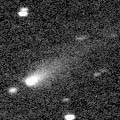
|
It will pass only 0.08 A.U. from the earth on May 12, remarkable approach after 76 years since its discovery in 1930. It was expected be so bright as 2 mag, but actually, it was fainter than its last appearance by 1.5 mag. Anyway, it will be 3.5 mag at best, and will be visible with naked eyes. It is already bright and visible visually, 12.3 mag on Feb. 27 (Seiichi Yoshida). Strongly condensed and easy to see. It keeps observable in good condition all through the encounter in May, while it will be brightening rapidly. Two other components B and G are also visible. The components B and G are fainter than the main component by 2.5 mag and 5.5 mag respectively. Due to the approach of the comet, Bootids meteor shower observed in 1930 may appear in outburst again in 2005 May and June. But the earth will not pass through the dust trail in calculation. It will be extremely close, down to only 4 arcmin, to another visual comet P/2004 VR8 (LONEOS) on Mar. 7.
Date(TT) R.A. (2000) Decl. Delta r Elong. m1 Best Time(A, h)
Feb. 25 13 52.27 12 23.5 0.830 1.656 130 12.5 3:34 (180, 43)
Mar. 4 14 1.48 13 21.5 0.729 1.589 134 11.9 3:15 (180, 42)
|

|
It was expected to reach to 9 mag in 2006 spring. But actually, it is much fainer than expected, 13.9 mag on Aug. 1 and 11.7 mag still on Oct. 27 (Michael Mattiazzo). It seems to be a comet with very slow brightness evolution. In addition, it has already started fading before the perihelion passage, 13.3 mag on Dec. 9 (Andrew Pearce) and 14 mag on Feb. 26 (Jim Gifford). It had been too low even in the Southern Hemisphere from January to February, however, it will be getting higher gradually after this. It will be observable also in the Northern Hemisphere after late March. Although it is much fainter than originally expected, it will be observable at 13 mag until May. However, because of the unusual light curve, the future brightness is uncertain.
Date(TT) R.A. (2000) Decl. Delta r Elong. m1 Best Time(A, h)
Feb. 25 20 32.49 -32 7.3 2.314 1.619 35 13.1 4:14 (297, 18)
Mar. 4 20 32.66 -29 33.1 2.246 1.635 41 13.1 4:22 (291, 23)
|
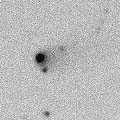
|
It brightened faster than a typical comet, and became visible visually as 13.5 mag in October (Oct. 24, Seiichi Yoshida). Now it is still bright as 13.4 mag (Feb. 27, Seiichi Yoshida). Small and strongly condensed. Because it is distant from the sun, it keeps observable at 13.5 mag in good condition for a long time until 2006 June.
Date(TT) R.A. (2000) Decl. Delta r Elong. m1 Best Time(A, h)
Feb. 25 9 50.04 53 18.6 4.453 5.202 135 13.5 23:28 (180, 2)
Mar. 4 9 46.53 53 8.5 4.492 5.199 131 13.5 22:57 (180, 2)
|

|
In 2005, outbursts occured in September and November, when it brightened up to 12.5-13 mag. It had been faint as around 15 mag in December and January. However, it has been bright at around 13 mag since late January. It was still bright as 12.5 mag on Feb. 22 (Juan Jose Gonzalez). But it will be too low to observe in late March.
Date(TT) R.A. (2000) Decl. Delta r Elong. m1 Best Time(A, h)
Feb. 25 2 3.95 21 53.3 6.211 5.790 60 13.7 20:11 (121, 5)
Mar. 4 2 8.41 22 7.3 6.307 5.792 54 13.7 20:00 (119, 3)
|
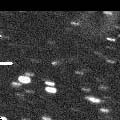
|
One of the split components born in outburst in 1995. It is brighter than its last appearance in 2001 by 1 mag. It has been brightening as rapidly as the main component. It is already visible visually at 14.4 mag on Feb. 27 (Seiichi Yoshida). It will pass only 0.067 A.U. from the earth on May 14, remarkable approach after 76 years since its discovery in 1930. It is fainter than the main component by 2 mag, but will be closer to the earth than the main component. It will reach to 5.5 mag, and double naked eye comets will be visible. It keeps observable in good condition all through the encounter in May. It will be within 1 degree from a visual comet P/2004 VR8 (LONEOS) on Mar. 10.
Date(TT) R.A. (2000) Decl. Delta r Elong. m1 Best Time(A, h)
Feb. 25 13 48.34 12 53.0 0.834 1.665 131 14.6 3:30 (180, 42)
Mar. 4 13 56.85 13 55.4 0.733 1.599 135 14.0 3:11 (180, 41)
|
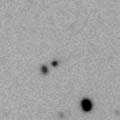
|
It was so faint as 18.5 mag at the discovery in early December, but it brightened up to 17 mag in mid January. Then it started brightening extremely rapidly after mid January. It was visible visually as bright as 14.0 mag in late February (Feb. 27, Seiichi Yoshida). Very strongly condensed and almost stellar. It will be observable in good condition at 14 mag until March. However, it will fade out soon after April.
Date(TT) R.A. (2000) Decl. Delta r Elong. m1 Best Time(A, h)
Feb. 25 10 16.15 17 17.7 0.797 1.782 171 14.8 23:55 (180, 38)
Mar. 4 10 17.50 19 40.9 0.805 1.778 163 14.7 23:29 (180, 35)
|
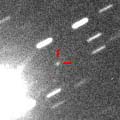
|
It has been brightening as 18.2 mag on Dec. 24 (Ken-ichi Kadota), 16.8 mag on Jan. 28 (Katsumi Yoshimoto). But it is a bit fainter than originally predicted by 0.7 mag. It is getting brighter rapidly in the morning sky. It will become visible visually at 13 mag in April, and will reach to 12 mag in June. The condition is best beucase it is almost at opposition at the perihelion passage. However, it will be very low, only 13-20 deg high, from June to September in the Northern Hemisphere. When it gets higher again, it will be fainter than 14 mag, too faint to see visually.
Date(TT) R.A. (2000) Decl. Delta r Elong. m1 Best Time(A, h)
Feb. 25 16 17.02 -16 0.1 1.528 1.834 90 15.4 4:14 (238, 60)
Mar. 4 16 32.26 -16 57.3 1.434 1.802 94 15.1 4:22 (232, 64)
|
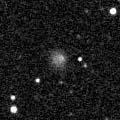
|
It had been an extremely faint Centaur asteroid until 2004, fainter than 21 mag. However, it brightened up to 17.5 mag on 2005 Dec. 30, and a coma was observed, then it was revealed to be a comet. It brightened furthermore, 14.8 mag on Jan. 7 (Ken-ichi Kadota). It was also visible visually at 14.4 mag (Jan. 8, Seiichi Yoshida). It looked like a planetary nebula. It was diffuse visually. It seems to be a temporary brightening in outburst. It kept bright at 14 mag until early February, but it faded down to 15.4 mag on Feb. 28 (Giovanni Sostero and Ernesto Guido). It will return to be so faint as 21 mag in the near future. It will pass the perihelion in 2015. The heliocentric distance reduces down to 5.9 A.U., but it will be 17 mag at best. However, another outburst may happen again in the future. It will be within 1 degree from another comet also registered as asteroid, 133P/Elst-Pizarro, on Mar. 1.
Date(TT) R.A. (2000) Decl. Delta r Elong. m1 Best Time(A, h)
Feb. 25 13 16.81 -6 7.2 12.241 12.972 136 15.2 2:59 (180, 61)
Mar. 4 13 15.72 -5 59.3 12.150 12.959 143 15.5 2:30 (180, 61)
|
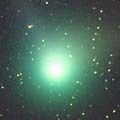
|
It was fantastic, so bright as 3.5 mag, so large as 30 arcmin, locating high overhead at its best time in early 2004 January. Then it had been getting fainter and smaller gradually, 12.5 mag on Sept. 3 (Edwin van Dijk) and 13.8 mag on Oct. 19 (Mitsunori Tsumura). After appearing again in the morning sky, it was bright as expected, 15 mag on Dec. 27 (Syuji Kashiwagi). It was not visible visually, fainter than 13.9 mag (Jan. 8, Seiichi Yoshida).
Date(TT) R.A. (2000) Decl. Delta r Elong. m1 Best Time(A, h)
Feb. 25 16 59.06 0 35.8 5.020 5.003 83 15.5 4:14 (232, 41)
Mar. 4 17 0.38 0 51.6 4.979 5.069 89 15.5 4:22 (222, 46)
|
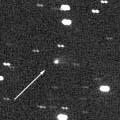
|
It will pass the perihelion soon, in 2006 February. But it did not brightened so much as expected, 15.7 mag on Dec. 18 (Ken-ichi Kadota). It keeps observable at 15-16 mag for a long time from 2005 spring to the end of 2006. Because it moves in the northern sky, it keeps observable for a long time in the Northern Hemisphere. It is brightest until May, but keeps lower than 30 deg high.
Date(TT) R.A. (2000) Decl. Delta r Elong. m1 Best Time(A, h)
Feb. 25 21 23.08 54 2.5 3.496 3.205 64 15.5 4:14 (224,-35)
Mar. 4 21 43.90 54 1.1 3.539 3.206 62 15.5 4:22 (224,-33)
|

|
Although it has already passed the perihelion in 2004 October, the fading after the perihelion passage is slow. It was visible visually still on Oct. 24 at 13.1 mag (Seiichi Yoshida). It was still bright, 14.6 mag on Dec. 31 (Ken-ichi Kadota). It will be unobservable soon. However, because it is distant from the sun, it will be observable again at 16.5 mag in autumn.
Date(TT) R.A. (2000) Decl. Delta r Elong. m1 Best Time(A, h)
Feb. 25 2 27.11 -6 3.7 6.528 6.068 58 15.5 20:11 (102, 27)
Mar. 4 2 28.50 -5 28.7 6.686 6.131 52 15.6 20:00 (100, 24)
|
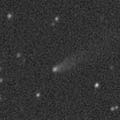
|
Although it was faint as 18 mag at the discovery in 2004 November, then it brightened very rapidly until early 2005, and reached to 16.0 mag on May 7 (Ken-ichi Kadota). After it appeared in the morning sky again, it continued brightening furthermore, and reached to 14.7 mag on Nov. 22 (Ken-ichi Kadota). It is also visible visually as 14.0 mag (Feb. 27, Seiichi Yoshida). After this, it keeps bright as 14-15 mag for a long time until spring. In the Northern Hemisphere, it keeps observable in good condition until summer when it becomes too faint. It will pass near by 73P from Mar. 7 to 10. Especially, it will be extremely close, down to only 4 arcmin, to the component C on Mar. 7.
Date(TT) R.A. (2000) Decl. Delta r Elong. m1 Best Time(A, h)
Feb. 25 14 8.72 13 22.3 2.029 2.739 126 15.7 3:50 (180, 42)
Mar. 4 14 7.75 13 49.2 1.993 2.765 132 15.7 3:22 (180, 41)
|
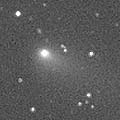
|
Although it was reported so faint as 17 mag at the discovery on Sept. 10 (M. E. Van Ness), it brightened rapidly and became so bright as 12.8 mag and visible visually in October (Oct. 24, Seiichi Yoshida). However, then it has been fading rapidly. It seems to have brightened temporarily in outburst. It faded down to 17-18 mag by CCD observations in January. Toni Scarmato reported it was 16.0 mag on Jan. 25, but extremely diffuse as DC=1. However, another small outburst occured again now. It somewhat brightened up to 15.6 mag on Feb. 12, and the central condensation became strong again (Ken-ichi Kadota).
Date(TT) R.A. (2000) Decl. Delta r Elong. m1 Best Time(A, h)
Feb. 25 2 28.28 24 13.7 3.470 3.210 66 15.9 20:11 (127, 7)
Mar. 4 2 36.83 24 35.1 3.586 3.236 61 16.1 20:00 (126, 6)
|
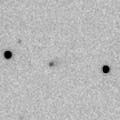
|
It brightened faster than a typical comet, and it reached to 16.1 mag on Dec. 13 (Ken-ichi Kadota). It will be observable in good condition as 16 mag for a long time until next spring.
Date(TT) R.A. (2000) Decl. Delta r Elong. m1 Best Time(A, h)
Feb. 25 10 38.34 67 7.3 4.378 4.976 122 16.0 0:21 (180,-12)
Mar. 4 10 32.94 67 4.7 4.415 4.977 119 16.0 23:44 (180,-12)
|
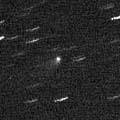
|
It was visible visually as 14.3 mag in 2005 spring (July 10, Edwin van Dijk). Now it is 16.7 mag (Dec. 18, Ken-ichi Kadota). Ken-ichi Kadota reported that a faint anti-tail is visible. Although it keeps 16.5 mag from December to early April, then it will fade out rapidly, and become fainter than 18 mag in July.
Date(TT) R.A. (2000) Decl. Delta r Elong. m1 Best Time(A, h)
Feb. 25 12 57.79 14 34.8 3.183 4.025 143 16.4 2:40 (180, 40)
Mar. 4 12 44.84 15 46.1 3.155 4.059 152 16.4 2:00 (180, 39)
|
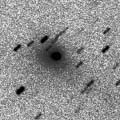
|
It has already gone far away, and it must have been around 19 mag in calculation. Actually, it was so faint as 18.3 mag on Jan. 8 (Ken-ichi Kadota). However, an unexpected outburst happened and it brightened up to 15.7 mag on Jan. 27 (Ken-ichi Kadota). Then it has been fading rapidly, but it is still bright as 16.6 mag on Feb. 25. Probably it is observable brighter than 18 mag until April.
Date(TT) R.A. (2000) Decl. Delta r Elong. m1 Best Time(A, h)
Feb. 25 15 7.34 -9 36.1 2.855 3.311 108 16.4 4:14 (200, 63)
Mar. 4 15 7.48 -9 36.3 2.797 3.350 115 16.5 4:22 (180, 65)
|
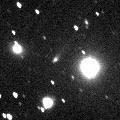
|
It had been observed at 16 mag by CCD, or 14 mag visually, in spring and summer in 2005. Now it is appearing again in the morning sky. It will be observable again at 16 mag in spring and summer in 2006. But the altitude will be somewhat lower than in 2005.
Date(TT) R.A. (2000) Decl. Delta r Elong. m1 Best Time(A, h)
Feb. 25 19 20.90 0 20.3 4.374 3.791 48 16.5 4:14 (259, 14)
Mar. 4 19 26.18 -0 8.5 4.315 3.805 53 16.5 4:22 (255, 21)
|
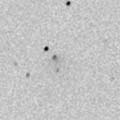
|
It passes the perihelion in 2006 February. But it is outside of Jupiter's orbit. So it keeps 17 mag for a long time. Because it moves in the northern sky, it keeps locating high and observable in good condition until 2006 summer.
Date(TT) R.A. (2000) Decl. Delta r Elong. m1 Best Time(A, h)
Feb. 25 15 29.02 68 9.9 6.484 6.798 104 16.6 4:14 (185,-14)
Mar. 4 15 24.27 68 39.6 6.482 6.799 104 16.6 4:22 (182,-14)
|
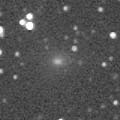
|
It reached to 11.4 mag in August (Aug. 12, Juan Jose Gonzalez). It was expected to start fading since early September. But actually, it keeps bright as 11.8 mag still on Oct. 7 (Juan Jose Gonzalez). Because it had been very low in the morning, it was not observed visually after that. Now it faded down to 16.6 mag (Jan. 28, Katsumi Yoshimoto). It will be close down to 0.4 degree to 129P, another 17 mag comet, and will be in the same CCD field on Mar. 16.
Date(TT) R.A. (2000) Decl. Delta r Elong. m1 Best Time(A, h)
Feb. 25 13 2.91 -9 59.7 2.075 2.886 137 16.6 2:45 (180, 65)
Mar. 4 12 53.17 -10 31.2 2.085 2.964 146 16.8 2:08 (180, 66)
|
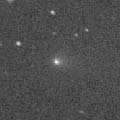
|
It was observed as 17.0 mag on July 10. Then it brightened as expected and reached to 15.0 mag on Oct. 1 (Mitsunori Tsumura). It was also visible visually as 13.5 mag Oct. 24 (Seiichi Yoshida). The second component was found at 18 mag on Nov. 30 about 20 arcmin from the main component. The main component also started fading, and it is 16 mag now. It will be too low to observe in the evening sky in mid April.
Date(TT) R.A. (2000) Decl. Delta r Elong. m1 Best Time(A, h)
Feb. 25 2 12.84 8 50.3 2.784 2.410 57 16.8 20:11 (113, 15)
Mar. 4 2 25.24 10 3.0 2.866 2.424 54 16.9 20:00 (113, 13)
|
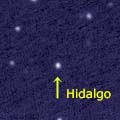
|
It reached to 13 mag and was observed visually in good condition in 2004 autumn. It has been not observable since August, but it is appearing at dawn again. It keeps 17 mag until late April. But it will go away soon after that. Next return is in 2018, when it will be 14.3 mag at best.
Date(TT) R.A. (2000) Decl. Delta r Elong. m1 Best Time(A, h)
Feb. 25 13 30.13 6 11.7 3.194 3.963 135 17.0 3:12 (180, 49)
Mar. 4 13 25.43 6 16.6 3.166 4.005 143 16.9 2:40 (180, 49)
|
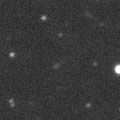
|
It was observed around 20 mag in early October, as bright as expected. Then it brightened rapidly and reached to 16.9 mag on Jan. 4 (S. Pastor, J. A. Reyes). It will be observable in good condition at around 17 mag from December to March.
Date(TT) R.A. (2000) Decl. Delta r Elong. m1 Best Time(A, h)
Feb. 25 11 5.18 -6 36.2 0.891 1.858 162 17.0 0:48 (180, 62)
Mar. 4 11 0.49 -6 36.6 0.899 1.878 166 17.1 0:16 (180, 62)
|

|
It will reach to 15.5 mag from late 2006 to early 2007 although locating rather low. It is observable around 17 mag from this winter to spring. It was observed as around 17.5 mag in early January.
Date(TT) R.A. (2000) Decl. Delta r Elong. m1 Best Time(A, h)
Feb. 25 9 22.75 -8 37.9 4.111 5.027 155 17.1 23:01 (180, 64)
Mar. 4 9 13.16 -8 22.7 4.108 4.991 149 17.0 22:24 (180, 63)
|

|
Peculiar asteroid with a comet-like orbit. Although it is not observable around the perihelion passage, it will reach to 17.5 mag only in a short time around March and November.
Date(TT) R.A. (2000) Decl. Delta r Elong. m1 Best Time(A, h)
Feb. 25 10 58.40 18 47.2 1.374 2.353 168 17.3 0:42 (180, 36)
Mar. 4 10 23.86 23 8.1 1.348 2.310 161 17.3 23:32 (180, 32)
|

|
It was observed as 17.6 mag on Jan. 3 (Ken-ichi Kadota). It will be observable at 18 mag in good condition until May.
Date(TT) R.A. (2000) Decl. Delta r Elong. m1 Best Time(A, h)
Feb. 25 14 44.61 67 20.0 4.555 4.961 108 17.4 4:14 (181,-12)
Mar. 4 14 27.62 68 59.8 4.550 4.961 108 17.4 3:42 (180,-14)
|

|
It reached to 17 mag in 2004 autumn. Although it has been not observable for a while, now it is observable as 17 mag in good condition again. It was reported as 18 mag recently, fainter than this ephemeris by about 1 mag.
Date(TT) R.A. (2000) Decl. Delta r Elong. m1 Best Time(A, h)
Feb. 25 7 10.52 16 55.6 2.633 3.361 130 17.5 20:50 (180, 38)
Mar. 4 7 10.32 17 1.4 2.726 3.376 123 17.6 20:22 (180, 38)
|

|
Second sub-component recovered on Feb. 20. Although it was fainter than 19 mag on Feb. 9, it was already bright as 18.1 mag on Feb. 13 (Ken-ichi Kadota). It brightened rapidly up to 17.5 mag on Feb. 25. It can be the component E, one of the split components born in outburst in 1995. If it is the component E, it is fainter than its last appearance in 2001 by 3-4 mag. But it will reach to 8.5 mag at the encounter with the earth in May. However, the component E faded before the perihelion passage in 2001. So the future brightness evolution is very uncertain.
Date(TT) R.A. (2000) Decl. Delta r Elong. m1 Best Time(A, h)
Feb. 25 13 47.66 12 58.0 0.834 1.667 131 18.1 3:29 (180, 42)
Mar. 4 13 56.06 14 1.1 0.733 1.600 135 17.5 3:10 (180, 41)
|

|
Observed almost as bright as expected in February. Although it will not approach to the earth so much in this return, it keeps observable all through the period in the evening sky until autumn. It becomes brightest in June and too faint in autumn. It keeps locating around 30 degree high after May. Great outburst over 6 mag has occured always in recent appearances in 1995 and 2001. The ephemeris says it will be 14 mag at best. But it is expected to be visible visually due to an unpredicted outburst again in this return.
Date(TT) R.A. (2000) Decl. Delta r Elong. m1 Best Time(A, h)
Feb. 25 5 24.43 17 16.5 1.141 1.696 105 17.9 20:11 (160, 35)
Mar. 4 5 27.34 18 16.8 1.155 1.636 99 17.7 20:00 (157, 33)
|
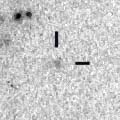
|
It is observable at 17.7 mag in 2006 spring. It is also observable at 17.5 mag in 2007 spring, but the altitude will be a bit lower.
Date(TT) R.A. (2000) Decl. Delta r Elong. m1 Best Time(A, h)
Feb. 25 11 29.98 7 6.7 3.907 4.871 165 17.8 1:12 (180, 48)
Mar. 4 11 26.67 7 25.8 3.880 4.865 172 17.8 0:42 (180, 48)
|
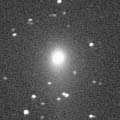
|
It was 17.3 mag on Nov. 1 (Ken-ichi Kadota), fading slowly as expected. It will be fainter than 18 mag in March. It keeps locating high.
Date(TT) R.A. (2000) Decl. Delta r Elong. m1 Best Time(A, h)
Feb. 25 13 15.40 39 41.6 4.392 5.114 132 17.8 2:57 (180, 15)
Mar. 4 13 9.72 40 5.8 4.419 5.172 135 17.9 2:24 (180, 15)
|
|
![]()
 2006 BZ8
2006 BZ8 C/2005 G1 ( LINEAR )
C/2005 G1 ( LINEAR ) 119P/Parker-Hartley
119P/Parker-Hartley 73P-G/Schwassmann-Wachmann 3
73P-G/Schwassmann-Wachmann 3 41P/Tuttle-Giacobini-Kresak
41P/Tuttle-Giacobini-Kresak 99P/Kowal 1
99P/Kowal 1 C/2004 Q1 ( Tucker )
C/2004 Q1 ( Tucker )![]()

























